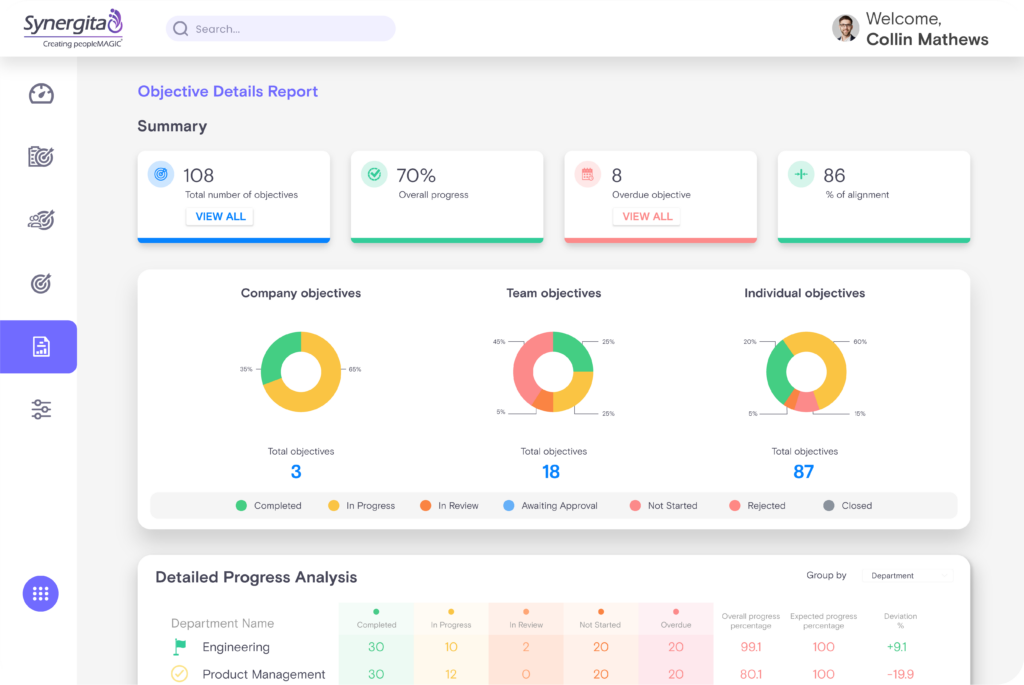From Goal Setting to Goal-Achieving: A Guide to Winning with OKRs in Companies
Are you tired of setting goals that don’t seem to go anywhere? Do you feel like you’re running in circles, chasing your own tail? Goal setting is an essential part of any business, and it’s critical to have a framework that guides this process to achieve your desired outcomes. Well, fear not! The Objective and Key Results (OKR) framework is here to help you achieve your goals and take your business to new heights. This is a very popular and effective framework that has been adopted by industry giants like Google, Amazon, Netflix, and many more! Even startups and small businesses have adopted this framework to ramp up their businesses.
The OKR framework has helped many organizations to achieve their set objectives and drive success. Since it provides a very clear and straightforward approach to goal setting that aligns company objectives with measurable results, it has been adopted by many companies, irrespective of their organization size. This blog post will take you through the OKR framework, providing insights into how to set specific, measurable, attainable, relevant, and time-bound goals, define key results, create a culture of accountability, and incorporate continuous improvement.
So, whether you’re a business owner, a manager, or an employee, this blog will provide you with valuable insights and tools to help you set and achieve goals that drive growth and success for your company.
Setting SMART Goals
When it comes to achieving success, setting SMART goals is an absolute must! The acronym SMART stands for Specific, Measurable, Achievable, Relevant, and Time-bound, which all play a crucial role in making your goals more attainable. By setting goals that are well-defined and quantifiable, yet still challenging and aligned with your company’s vision, you can create a sense of urgency and motivation that propels you towards success. The goal that meets the criteria below is more likely to be achieved than one that does not.

Specific: A specific goal is one that is well-defined and clearly articulated. The more specific the goal, the easier it is to measure progress and identify areas for improvement.
Measurable: A measurable goal is one that can be tracked and quantified. This helps to ensure that progress is being made and allows for adjustments to be made if necessary.
Achievable: An achievable goal is one that is challenging but still attainable. Setting unrealistic goals can lead to frustration and demotivation.
Relevant: A relevant goal is one that aligns with the overall mission and vision of the company. It should be something that is important to the business and will contribute to its success.
Time-bound: A time-bound goal is one that has a specific deadline for completion. This helps to create a sense of urgency and ensures that progress is being made in a timely manner. Rephrase it in an interesting and engaging way.
These aspects ensure that businesses have a clear path to follow, reducing ambiguity and increasing the chances of success.
Understanding the OKR Framework
The OKR framework is one of the most simple and effective frameworks that allows one to set goals clearly without any ambiguity. It is widely used by many companies to align their goals and track progress towards accomplishing the same. This framework comprises two important components:
- Objectives: These are high-level goals set by the company, team, and individuals to achieve them. They should be specific, measurable, achievable, relevant, and time- bound.
- Key Results: These are specific and measurable outcomes that will project progress toward achieving the objectives. They should be inspiring, achievable, and focus on the outcomes rather than the activities.
Apart from these components, there are a few points that must be considered when one creates OKR. A few of them are listed below:
- OKRs should be set on a quarterly basis and reviewed regularly to track progress.
- OKRs should be aligned with the company’s overall strategy and vision.
- OKRs should be transparent and visible to all the stakeholders of the organization.
Netflix, Amazon, and many other giant players have effectively used OKR to achieve the set goals. The framework that they have set mainly focuses on the following:
- Focus on what matters
- Unleash creativity and innovation
- Experimentation and learning
- Lead with context and empathy
- Plan
- Iterate
- Validation
- Obtain data and feedback
- Test and learn
Overall, the OKRs should be critical drivers of progress towards the objectives.
Defining Key Results
Key results are measurable outcomes that are used to track progress towards achieving specific goals or objectives. KRs are typically set for a specific period of time and are used to monitor progress towards achieving a larger goal.
- Key results are specific and measurable indicators that are used to track progress towards achieving a goal.
- Key results are often used in conjunction with OKRs (objectives and key results) to ensure that progress is being made towards achieving specific objectives.
- Key results should be relevant to the objective being pursued and should be realistic and achievable.
- Key results should be time-bound, meaning that they should have a specific deadline for when they need to be achieved.
- Furthermore, key results should be tracked regularly to ensure that progress is being made and adjustments can be made if necessary.
- Finally, key results are an essential tool for organizations and individuals to track progress and achieve their goals effectively.
Aligning Goals and Key Results
Aligning goals and key results (OKRs) is a strategic framework that can help organizations and teams achieve their objectives by setting specific, measurable goals and tracking progress through key results. Here are some steps to align goals and key results effectively:
Define your overall strategic objectives: Before you set specific goals and key results, you need to have a clear understanding of your organization’s strategic objectives. These objectives should guide the goals and key results you set.
Set specific, measurable goals: Set specific, and measurable goals that are aligned with your strategic objectives. These goals should be challenging but achievable, and they should have a specific timeline for completion.
Identify key results: Once you have set your goals, identify the key results that will help you track progress towards those goals. Key results should be specific, measurable, and time-bound, and they should provide a clear indication of progress towards achieving the goal.
Ensure alignment: Ensure that each team member’s individual goals and key results are aligned with the organization’s overall objectives. This will ensure that everyone is working towards the same goals and that progress is being made in the right direction.
Regularly review progress: Regularly review progress towards goals and key results. This will allow you to identify areas where progress is not being made as quickly as expected and to adjust your strategy accordingly.
Celebrate successes: Celebrate successes, big or small, along the way. This will help to maintain motivation and momentum towards achieving your goals.
By following these steps, you can align your goals and key results effectively, helping to ensure that your organization is working towards its strategic objectives and making progress towards achieving its goals.
Creating a Culture of Accountability
Creating a culture of accountability in an organization is essential for ensuring that employees are responsible for their actions and work towards achieving the organization’s goals. Here are some steps that can be taken to create a culture of accountability:
- Define roles and responsibilities: Make sure that each employee knows their role and responsibilities, as well as the expected outcomes and goals associated with their job.
- Set clear expectations: Establish clear expectations for performance and behavior and communicate them to employees. Ensure that the expectations are achievable and aligned with the organization’s goals.
- Provide the necessary resources: Ensure that employees have the resources they need to do their jobs effectively. This includes training, equipment, and support from management.
- Encourage open communication: Encourage open communication between employees and management. Provide channels for feedback and encourage employees to voice their concerns or suggestions.
- Hold employees accountable: Hold them accountable for their actions and performance. Set clear consequences for failing to meet expectations and ensure that they are enforced consistently.
- Recognize and reward accountability: Recognize and reward employees who demonstrate accountability. This can be done through incentives, promotions, or other forms of recognition.
When an organization starts following these steps, it will pave the way for a culture of accountability that promotes responsibility, transparency, and commitment to achieving organizational goals.

Incorporating Continuous Improvement
Continuous improvement is an essential aspect of any performance management system, and it can also be applied in the context of OKRs. Here are some ways to incorporate continuous improvement into the OKR process:
- Regularly review and adjust OKRs to identify areas that need improvement.
- Seek feedback from team members, stakeholders, or customers to make OKRs more relevant and effective.
- Use data to inform decision-making and adjust objectives accordingly.
- Encourage experimentation and innovation to improve business processes.
- Celebrate successes and learn from failures to motivate team members and identify areas for improvement.
Moreover, OKR is not a one-time event. It requires the incorporation of continuous improvement to ensure the relevance and effectiveness of the set OKRs. This can help businesses identify any roadblocks and make necessary changes to ensure that they stay on track towards achieving their objectives.
Conclusion
The key to success is getting everyone in the company to focus on the objectives, not the process. This is precisely what the OKR framework does: it ensures that businesses set well-defined and measurable goals that are aligned with their vision and mission.
The proof of the pudding is in the eating, as they say, and the success of the OKR framework is evident in companies like Netflix and Amazon, which have implemented it with tremendous success.
In today’s fast-paced business environment, setting goals and achieving them are critical for success. By embracing the OKR framework, companies can create a sense of purpose, foster collaboration, and drive innovation. It is not just a tool, but a mindset that can transform how organizations operate and succeed. So, if you want to achieve your goals and thrive in today’s competitive marketplace, consider adopting the OKR framework and watch your business soar to new heights!
